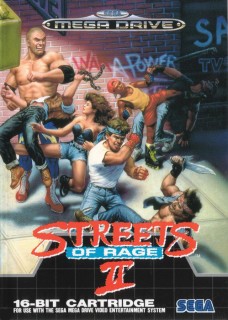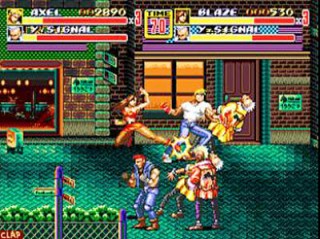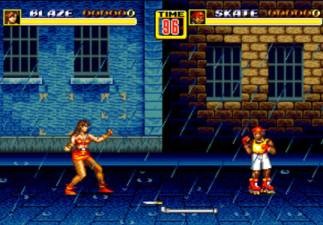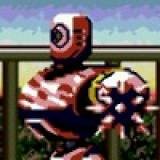
I was one of those who did pick it up at release. I remember queuing up in Derby's ComputerGenie of a Saturday morning just as the SoR2 shipment came in and eagerly handing over my £44.99. Yes, it was a lot of dough then but I certainly wringed every bit of value from this 16 megabit beastie (that's just two megabytes in today's money, in case you were wondering). It still got an occasional whirl long after I'd gone off games, that was until some arsehole nicked it from the communal MegaDrive pile in my halls of residence. I never forgot it though, and in 2012 - a gap of 16 years - I was able to reacquire this gaming tour de force for a reasonably priced tenner.
What's the fuss about? 22 years ago the battle for market supremacy between Sega and Nintendo was at its height. The Super Nintendo Entertainment System was kitted out with hardware that, pound for pound, knocked Sega's machine out the ring. However, the front line was not so much what each console could and couldn't do. It came down to the games. Just like today, system exclusives helped drive sales and back then Nintendo had locked down pretty much all the large Japanese and American software houses. Until US courts forced them to scrap anti-competitive licensing arrangements, the big coin-ops and franchises went to the SNES. One such game was Capcom's Final Fight, which was (then) exclusively converted to Nintendo's 16-bit console (an outing for Sega's Mega CD was to come). Final Fight was a huge deal in the arcade with its pseudo-3D play field, choice of three characters and multiple moves. The sprites were large and the fighting action especially meaty. As a package, it was a step up from what went before: a logical progression from Technōs tired-looking Double Dragon series and its epigoni.
At this point, Sega was having to rely on a stable of exclusive conversions of its own arcade games and specially developed software. Hence many Nintendo titles were "replied" to by Sega for the MegaDrive and the 8-bit Master System. The first Streets of Rage was in this mould. Three characters to choose from, multiple moves, pseudo-3D play field. You get the picture. Unlike the SNES conversion of Final Fight, you could have two players simultaneously who variously combined to produce unique special moves. It also had a stomping techno soundtrack the likes of which had never previously been heard in a video game. As a defensive riposte, it was arguably a Final Fight beater, received almost universal praise and sold bucket loads. A sequel was inevitable.

The four characters have their own unique sets of moves, strengths and weaknesses. The strongest is the lumbering Max, a man mountain whose spine-busting knee smash is the game's most devastating attack. Next is Axel, modelled closely on Cody from Final Fight. In my opinion he's the dullest character with the most boring move set, but his uppercut comes in handy for airborne foes. The best is Blaze, the all-rounder. As the game's token woman her moves are the most acrobatic but best equipped for a single player play through. Lastly there is Skate, a streetwise kid who can dart all over the screen and unleash some devastating attacks. Have you ever been kicked by someone in rollerblades? Ouch.
The original Streets of Rage was notable because, as far as I know, it featured the first black player character in a video game. Adam returns in the sequel, but this time he's gone and got himself kidnapped by the evil Mr X. Luckily, his kid brother Skate is to hand ... This itself is an interesting about turn of beat 'em up conventions. Typically the plot of these games revolved around rescuing some hapless woman - a girlfriend in Double Dragon, a girlfriend and a daughter in Final Fight, etc. Playing as Blaze you have the then unheard of scenario of a woman fighting through hordes of enemies to save her pal. A nice subversion of the not-so-fine tradition of abduction in video games.
One thing Streets of Rage 2 shares with other beat 'em ups of the time is the lawless backdrop. I can't think of one predecessor game - Ninja Warriors, Shadow Warriors, Crudebusters, Vigilante, Renegade not set in a city fallen to the ravages of organised crime. As a plot device, there is an element of practicality to it. Who is it okay for good guys to beat up? Crims are ideal punch bags. There's no moral quandary for starters and it reinforces a sense of right and wrong. But also, SoR2 and co. feed off late 80s/early 90s cultural anxieties: a feeling that social mores are decomposing, that the law was fraying and breaking, that urban spaces were places of danger. After dark, law abiding citizens were at risk of getting mugged or murdered. It's not for nothing that all of SoR2's urban levels take place at night. Coincidentally, in the early 90s city centres across Western Europe and North America were getting cleaned up and made safer as spaces for consumerism. What SoR2 draws on is the cultural memory of how New York had decayed into a risky place in the late 70s and early 80s. Yet alongside the crime it retained a gritty sort of urban glamour. This is faithfully reproduced in SoR2. As you cleave into Mr X's syndicate the flashing neon of a hip, happening city is your canvas. The pumping soundtrack underlines its dangerous but enticing allure.


SoR2 draws on what were dated, questionable memes back then. But it demonstrates perfectly the double edge of video games. As a medium it is the most modern, most contemporary of art forms. In its day, SoR2 was at the vanguard of video game design. In every way it was a technically accomplished product assembled by a programming team at the top of their game. Its combined pushing the MegaDrive to its limits with the most perfect beat 'em up playability. SoR2 has long held its place in the canon, and deservedly so. Yet even then, the dazzling pixels and amazing sound were bundled with some pretty grubby social attitudes. This game came out 21 years ago, and so could be alibied by referencing the attitudes of the day. And yet product with exactly the same sorts of issues continue to pollute contemporary games systems. What's their excuse?
No comments:
Post a Comment